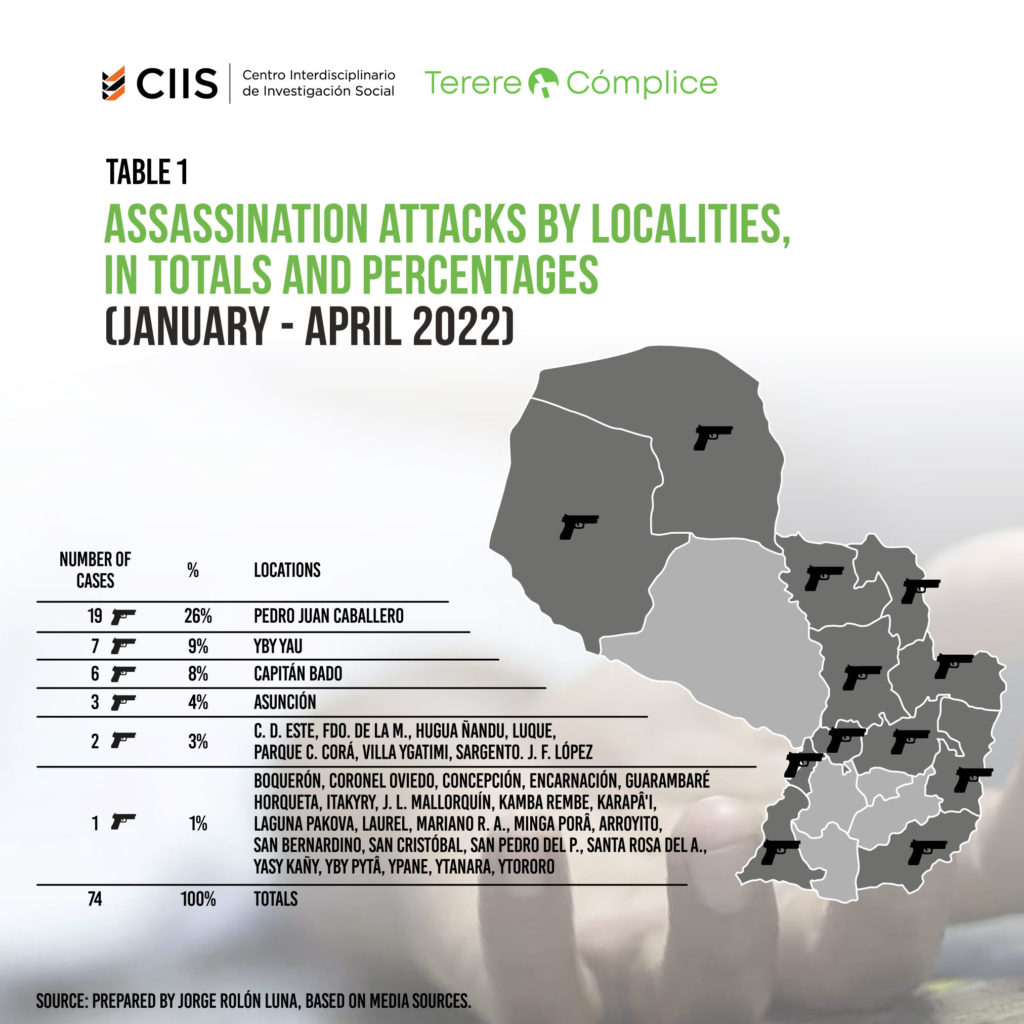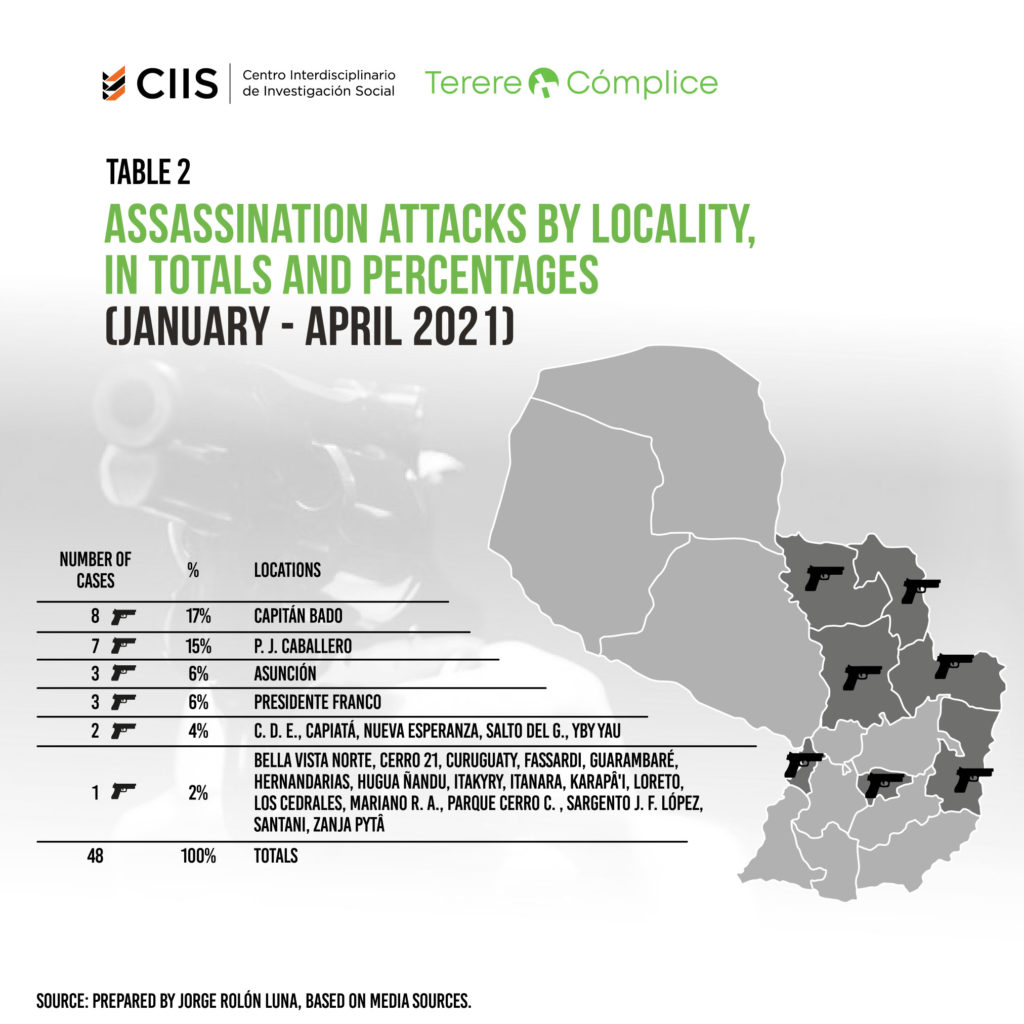
By Jorge Rolón Luna**
Homicide is the worst and most extreme form of censorship. In turn, when ending a life is as easy as having the money to order it done -because the manpower is available-, the social consequences can be catastrophic. For this reason, the expansion of hired assassination is something that must be carefully analyzed and addressed with urgency and energy. Something that is probably long overdue.
In the previous article on geolocation, I analyzed the data on contract killings for the first four months of the year, taking into consideration cases by department. In that article I showed findings that could be considered quite surprising, such as that in 2021 and 2022, the department of Amambay, usually considered the privileged territory in drug violence, represents today less than half of the cases of contract killings (39%), with 9 other departments sharing the rest, among which Concepción, Central, Canindeyú and the capital of the country play an important role. I then confirmed the validity of the common sense about hired killings, with ideas such as “hired killings are expanding” and that “Amambay is a hot spot” (although less and less important, percentagewise).
I used an analogy that I consider useful to understand what is happening in our country with contract killings: the phenomenon of the oil slick. This analogy has two meanings. On the one hand, it includes the idea of the spatial expansion that characterizes the spill of liquids, such as oil in the sea, and on the other hand, it incorporates the notion that this expansion in its path it kills fauna, flora and other living beings. Hitmen is somewhat identical. It has deleterious and destructive effects in multiple dimensions, as it blinds individual lives but also crushes social and political life and, finally, the rule of law.
On this occasion, and already based on previous findings, I will quantify and individualize this territorial expansion of hired killings, but from the perspective of the cities, areas, and geographical points in which they have occurred in the first four months of this year, comparing them with the first four months of the year 2021.
As the electoral process for the next national and departmental elections is already underway, the silence of the candidates for different positions and especially of those running for presidency (with the exception of one of them), is both striking and hopeless at the same time. The local and international experience in this matter is directly linked to the approach that a State has with respect to the use of substances that produce effects on the central nervous system.
The following graph shows the comparison between the two years, by areas and their respective variations. A preliminary conclusion is that, in general, as the number of cases increases in the country, so does the number of cities and towns where these events occur. This increase is in absolute and relative terms, with a few exceptions (Capitan Bado, for example). Another issue that stands out is that Asunción is no longer a place where people kill by chance. Something is happening in the capital of the country, since numbers and percentages are repeated. We will get back later to the specific and detailed analysis of these two periods under consideration.

Now, let’s look at the statistics only from January to April of the current year 2022. The city of Pedro Juan Caballero leads with 19 cases and, not so surprisingly, in second place comes Yby Yau with 7 cases, followed by Capitán Bado with 6 and, in fourth place, Asunción with 3 cases.

A minimal reading of these numbers underscores the preeminence of Amambay cities such as Pedro Juan Caballero and Capitán Bado, which last year occupied first and second place, now occupy first and third place, respectively. Also, there is the increase of cases in Yby Yau, a place that can be considered a “narco territory” for some time now, which went from fourth place in 2021 to second place in 2022.
What do the percentages tell us? First, a not inconsiderable increase in cases in Pedro Juan Caballero (17% to 26%), another remarkable increase in cases in Yby Yau (4% to 9%), while a usual hot spot like Capitan Bado went from first place to third (17% to 8%).
As for Yby Yau, its increase may have to do with the high level of marijuana farming and trafficking in the Concepción department. To this, we must add its proximity to the Paraguayan Chaco, a territory of clandestine airstrips where planes with cocaine load up from producing countries (Colombia, Peru, Bolivia). In addition, Concepción is a point of entry of this cocaine into Brazil, with whom it borders, which suggests disputes between drug trafficking groups in that area of the country.
In terms of cases, Asunción cannot go unnoticed either. In addition, the same number of cases is repeated in 2021, so it can be said that the activity of hired killers in the capital is no longer a coincidence, with a 4% of the total so far this year. To provide additional information, the disaggregated data of cases for the first four months of 2021 is added below.

The comparison by number of locations shows that in the period considered in 2021 there were contract killings in 26 different geographic locations, in 2022 there were in 36, a 38% increase in the geographic diversification of contract killings.
Of these 36 sites impacted by hitmen attacks in 2022, the following locations are repeated from 2021: P. J. Caballero, Yby Yau, Capitán Bado, Asunción, Ciudad del Este, Hugua Ñandu, Parque Cerro Corá, Guarambare, Itakyry, Karapã’i, Mariano Roque Alonso, Sargento José Félix López (Ex Puentesinho), Santani and Ytanarã. It can be considered, in principle, that the repetition sheds some light on the activity of drug trafficking groups, given the difficulty of this fact being fortuitous, taking into consideration the characteristics of hired assassination in Paraguay, closely linked to the world of drug trafficking.
To conclude, it is obvious that, for some time now, the oil slick has been spreading and blinding human lives without the State or society reacting to stop, at least, its uncontrolled expansion. As the electoral process for the next national and departmental elections is already underway, the silence of the candidates for different positions and especially of those running for presidency (with the exception of one of them), is both striking and hopeless at the same time. The local and international experience in this matter is directly linked to the approach that a State has with respect to the use of substances that produce effects on the central nervous system. The “war on drugs” has not only been an absolute failure in terms of preventing the availability of prohibited substances but has also brought with it the violence of drug trafficking, given the connivance between important political actors and groups of drug traffickers, with special emphasis on border areas or areas of drug production and trafficking. There have never been so many drugs in quantity and variety on the streets, in other words. The evidence that a new approach is urgently needed, one that puts the legalization and decriminalization of everything related to today’s prohibited drugs first, cannot be postponed. It will be essential to purge our political and security forces, co-opted or associated with the drug trade, as well as vast sectors of our justice system, which require a thorough overhaul. Business as usual will only worsen violence and deaths, as recent and current history proves.
Cover image: Colprensa
*This article was written before the attack that cost the life of anti-drug prosecutor Marcelo Pecci in Colombia and before the attack against the mayor of Pedro Juan Caballero, José C. Acevedo.
** Lawyer, Professor, independent researcher, expert in Human Rights. Former director of the Observatory of Security and Citizen Coexistence of the Ministry of the Interior.
